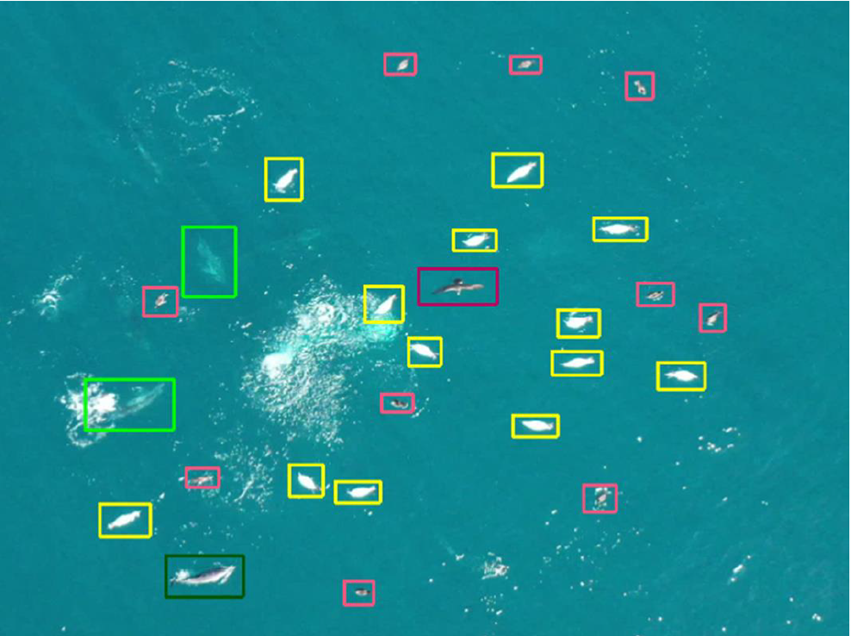Pulse of the Gulf
Who
Professor Rochelle Constantine, Associate Professor Craig Radford – University of Auckland, Professor Cliff Law – NIWA, , Dr Mark Johnson – University of St Andrews, Scotland.
Project Toroa—Tane van der Boon, Jason Dunn, Willy Wang, and Dr Nick Rattenbury –University of Auckland.
Far Out Ocean Research Collective—Jochen Zaeschmar
2019-2021
Awarded
$211,250
“Mega-fauna are the Pulse of the Gulf; if the Gulf is healthy, they are healthy.”
The Hauraki Gulf – Tīkapa Moana/ Te Moananui-ā-Toi – is a global hotspot for mega-fauna diversity (large marine species such as whales, dolphins and sharks). The state of their ecosystem makes the difference between staying or going and between life and death for these large iconic creatures. They are quickly impacted by oceanic change and given their role as large predators, they are the first to disappear if food is not plentiful.
Prior to human arrival these waters were teeming with life. Vessel strike, habitat degradation, shifts in prey availability and climate change are key threats to marine mammals. Mitigation of these threats requires informed decision-making processes to ensure successful outcomes. The resident whale and dolphin populations provide unique insights into the Gulf as they require abundant zooplankton and fish to sustain their year-round presence.
The focus of this project was to understand the lives of large marine animals in the Hauraki Gulf - Tīkapa Moana - Te Moananui-ā-Toi. The team used innovative approaches to gather environmental data to inform conversations and actions to heal a damaged Gulf. These approaches included:
The use of long-range drones and artificial intelligence (AI) to review footage to understand the community composition and interactions between species.
A drone image of a multi-species workup with annotations in the form of different coloured boxes highlighting the different species and behaviours. Sitting gannets (yellow), gannets underwater – as indicated by the bubble trail (light green), shearwaters sitting (light red), common dolphin swimming (dark red) and turning (dark green). Taken under DOC permit.
The use of a novel high-tech approach with next generation D-tags, hydrophones and a drone to simultaneously track the 3-D movements, dive profiles, speeds, orientation, acoustic space, and prey-field recording of Bryde’s whales.
Drone image of Bryde’s whale engulfing anchovies in a work-up including gannets, fluttering shearwaters and common dolphins. Taken under DOC permit.
Simultaneous recording of an olfactory cue—dimethylsulphide (DMS), whilst recording the prey field and presence of marine mammals and seabirds to provide the first assessment of the importance of this plankton by-product in driving marine mammal, and seabird, distribution in the Gulf.
The use of passive acoustic hydrophone arrays to understand the soundscape and impacts of humans (boat noise) in shallow coastal waters.
The project team has completed 45 field trips since September 2019. During that time they collected boat-based behavioural observations, drone footage, DMS samples and acoustic data.
The AI development is nearly complete with the final model runs due for completion mid-March 2022. The team continues to collect aerial footage to inform the machine learning tools and increase accuracy of species identifications and behaviours. They will use AI to analyse the fine-scale interactions within and between species in the work-ups.
The findings of the project have been shared through media articles, an opening talk for the WWF Whales Tales Seminar Series, conference presentations and via peer-reviewed articles.
The team has identified eight different communities largely comprising seabirds, whales and dolphins but occasionally sharks, manta rays and fur seals in the Gulf. With the loss of the fish-feeding community associated with Bryde’s whales once they switched their diet mainly to zooplankton (Gostischa et al. 2021) a new community has emerged, with storm petrels and Bryde’s whales foraging on zooplankton. With decreases in fish populations, these communities do not function optimally.
The negative impact of small boat noise on the hearing ability of animals in shallow, nearshore environments is very clear. The persistent but variable sound produced by small boats impacts the mauri of these waters and should be considered when evaluating and mitigating the human impacts on coastal marine ecosystems (Wilson et al. 2022). The team has developed AI tools whereby managers could audit images of boats in nearshore habitats to understand the potential levels of noise in areas that require protection.
An opportunistic project on microplastics revealed that every whale in the Gulf consumes around three million microplastics (<5 mm), every day (Zantis et al. 2022).
The teams earlier work has shown that warmer sea-surface temperatures affect movements of Bryde’s whales and common dolphins, most likely due to plankton movement. With a predicted increase in marine heatwaves due to climate change, this is of concern for ecosystem function and ultimately the survival of these large inhabitants of the Gulf.
What next
The work was slowed by COVID-19 restrictions, with data collection severely compromised at multiple stages – especially during the Auckland lockdowns from August 2021. The team has extensions to their permits until the end of August 2022 to enable completion of most of their work. The acoustic analysis and interpretation of the soundscape of the Gulf is in its final stages. Fieldwork to map the profiles of DMS concentrations in the Gulf are planned for late 2022 or early 2023.
The research on the community structure will be completed in late March 2022 and will be communicated alongside other findings. The team have recently incorporated their work on manta rays (in collaboration with Manta Watch and Conservation International Aotearoa) into this project and a PhD student will be joining the team in 2022. They have observed oceanic mantas feeding in the same area as the Bryde’s whales as they both target swarms of krill in the outer Gulf waters. There are strong mana whenua connections to the rays and the team will continue to kōrerō with Ngāti Manuhiri as this work progresses.
With the increasing awareness that the Gulf is degraded, the team is looking forward to sharing its findings to inform future directions and actions to restore the mauri of Tīkapa Moana/ Te Moananui-ā-Toi.
Links to peer-reviewed publications:
Presentations:
Opening talk for WWF Whales Tales Seminar Series January 2022


